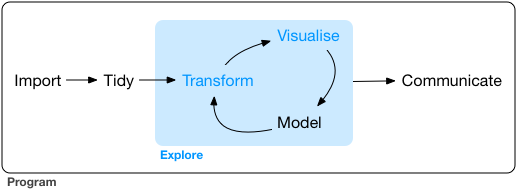Accessing data from the Internet
🗺
Transport Data Science
Invalid Date
Objectives
Learn where to find large transport datasets and assess data quality
Learning outcomes
Identify available datasets and access and clean them
This lecture will…
- Be primarily practical
- Provide an overview of data access options
- Show how R packages and web services provide access to some datasets
Data access in context
- Data cleaning (or ‘tidying’ or ‘wrangling’) is part of a wider process (Wickham, Cetinkaya-Rundel, and Grolemund 2023)

It’s important to have an idea where you’re heading with the analysis
Often best to start with pen and paper
Data access/cleaning vs modelling time
Tapson’s Rules of Machine Learning:
4. Time spent on data cleaning is an order of magnitude more productive than time spent on hyperparameter tuning.
(Extreme example: achieved a Top 10 result in Kaggle using linear regression, as the only team that cleaned 50/60Hz noise first.)— Jonathan Tapson ((jontapson?)) March 5, 2019
Source: https://twitter.com/jontapson/status/1103024752019402753
background-image: url() background-size: cover class: center, middle
A typology of data sources
Information and data pyramids
Data science is climbing the DIKW pyramid

A geographic availability pyramid
Recommendations
Build this here!
City-specific datasets
- Bristol cycle count data
Hard-to-access national data
Open international/national datasets
- Open origin-destination data from UK Census
Globally available, low-grade data (bottom)
- OpenStreetMap, Elevation data
An ease-of access pyramid
- Data provision packages
- Use the pct package
- stats19 package
- Pre-processed data
- E.g. downloading data from website www.pct.bike
- Messy official data
- Raw STATS19 data
A geographic level of detail pyramid
- Agents
- Route networks
- Nodes
- Routes
- Desire lines
- Transport zones
Observations
Official sources are often smaller in sizes but higher in Quality
Unofficial sources provide higher volumes but tend to be noisy
Another way to classify data is by quality: signal/noise ratios
Globally available datasets would be at the bottom of this pyramid; local surveys at the top.
Which would be best to inform policy?
Portals
- UK geoportal, providing geographic data at many levels
- Other national geoportals exist
- A good source of cleaned origin destination data is the Region downloads tab in the Propensity to Cycle Tool - see the Region data tab for West Yorkshire here, for example
- OpenStreetMap is an excellent source of geographic data with global coverage. You can download data on specific queries (e.g. highway=cycleway) from the overpass-turbo service or with the osmdata or osmextract packages
Online lists
For other datasets, search online! Good starting points in your research may be:
- The open data section in Geocomputation with R (r.geocompx.org/read-write)
- Transport datasets mentioned in data.world
- UK government transport data: Department for Transport
Data packages
- The openrouteservice github package provides routing data
- The stats19 package can get road crash data for anywhere in Great Britain (Lovelace et al. 2019) see docs.ropensci.org/stats19
- The pct package provides access to data in the PCT project, including origin-destination data for the UK (Lovelace et al. 2017) see github.com/ITSLeeds/pct
- There are many other R packages to help access data, including the spanishoddata package for Spanish origin-destination data
Practical demo
See practical session at itsleeds.github.io/tds/p2/
That involves:
Getting data from OSM: overpass turbo
Data from stats19
Data from the Census
Bonus: getting data from Cadence platform